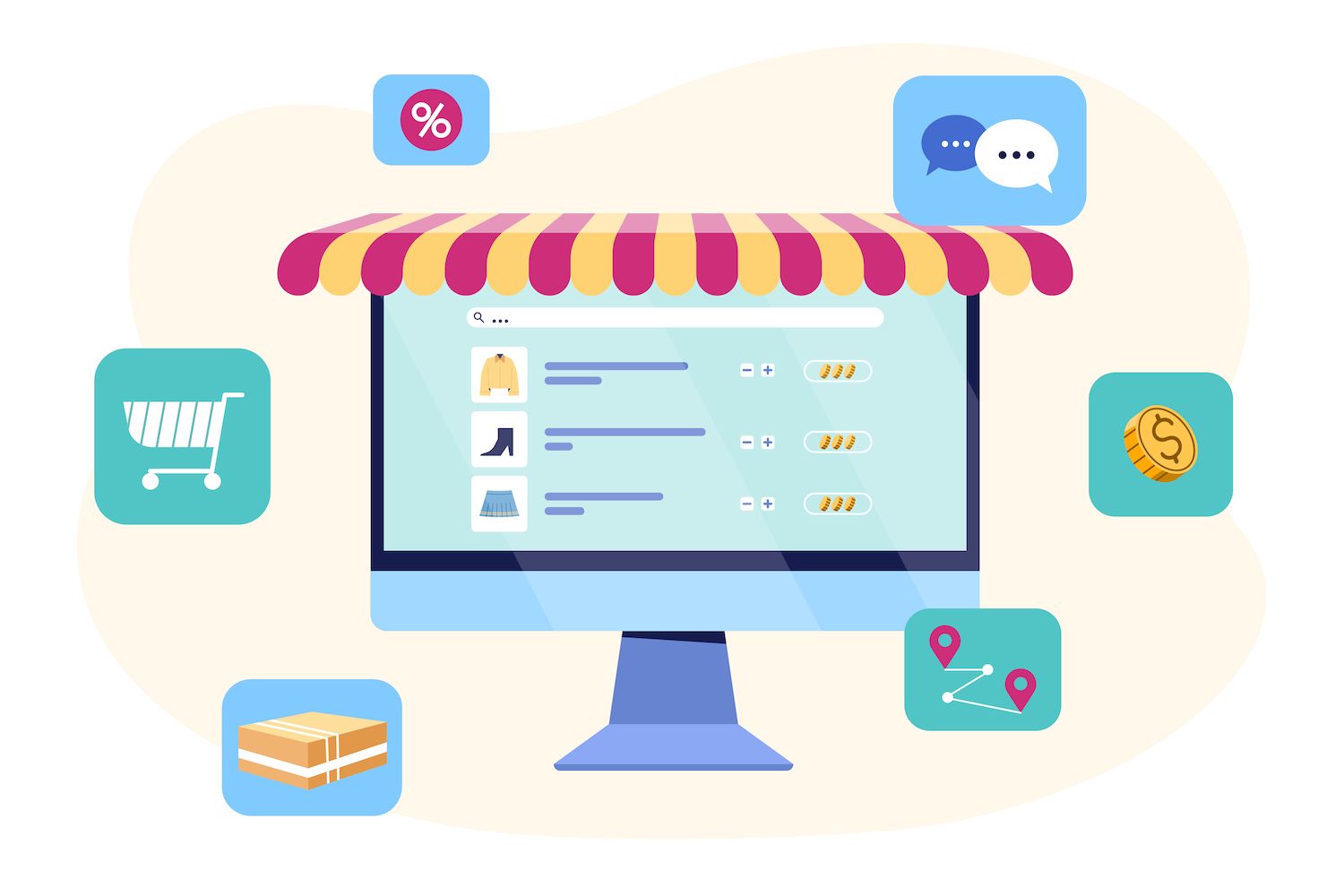Ecommerce Fundamentals of Accounting: Fundamentals for a Successful Store
The running of an online business requires more than good ideas and products, but also marketing and inventory. You also need an ecommerce accounting system that can track the financials. How much are you spending? What are your profits? Do you have enough money in your budget for your business? Do you have the approval of the government for your business? Ecommerce accounting is a well-known method to track the financial information of your business and transactions, and staying updated on taxes, payroll, and profits.
If you're starting your ecommerce store or have been at it for a little while and you realize that require help in tracking your company's financials, this accounting guide will assist you in getting on the right track.
Accounting for Ecommerce allows you to judge the financial health of your business, and to make better financial forecasts when the business expands.
What is the ecommerce accounting process?
Businesses that are based on e-commerce are built upon the transactions that happen and also inventory. It is where you make the sales. You distribute products. You purchase inventory and refill it.
The fundamentals of accounting for e-commerce start with a method of recording and reporting your transactions. These include purchase orders, invoices, expenses, and taxes.
It goes further than this. Accounting firms will then utilize the data they collect and it to produce financial statements so they can evaluate and present the financial health of your business.Ecommerce companies also require some specialized attention due to the basic principles of the business model.

Think about what happens when you make a sale in your online shop. The customer will use their credit card to make the payment to your processor. Which are the different ways the sale impacts your financials?
- Your payment processor has received money, but it's not in your bank account yet
- Sales taxes are incurred at times, and could be from another nation or state
- Inventory declines
- Payment processor and credit card charges are incurred
- The actual income from sales is different from the price of sale
No matter the sales channel the one sale can impact numerous areas of your financial record. And the aftereffects of this one transaction will show up on your financial statements in the coming months. If the purchase does return, the majority of these transactions will need to be reversed or modified.
That's only one purchase.
Monitoring some of these is the job of a bookkeeper. we'll discuss the distinctions between ecommerce bookkeeping and account some time later.
First, let's begin with the most basic accounting terminology.

Basic accounting terms
Here are the most important words to be aware of for accounting:
Transactions
In accounting terminology, a transaction occurs when money is transferred, spent, or demanded by a business or vendor.
An transaction can be one of the above:
- A business's owner can invest money in the business
- The revenue from sales
- Invoices
- Costs such as salaries or travel costs, marketing and construction cost
- Assets purchased, such as vehicles, office equipment properties, materials, etc.
One transaction may comprise multiple elements. When you pay an hourly employee such as a salesperson, you have to know the amount of time they worked, the net wages, tax deductions as well as their net earnings. The best accounting software is able to perform these functions.
Transactions for ecommerce companies can get complicated due to specific factors, including taxation and delays in timing due to the rift between consumer and business.
As an example, would you apply sales tax on the day of purchasing? If so, what happens to that cash if your product is return a month later?
Accounting for Ecommerce aims to control the processes and transactions so that such issues don't impair the financial performance of your enterprise.

Debits and credits
Every transaction is tracked through the system of debits and credits. Before we begin, let's look at the most important phrases:
Debit: A record of the amount taken from your bank account. It will appear on your bank statement whenever you purchase.
Credit: A record of the funds you have added to your account.
Assets: Property (real as well as intellectual) that is owned by an organisation.
Liabilities: Business obligations that have yet to be fulfilled. The term "liability" refers to a claim against the asset shown in a balance sheet.
Equity is the sum of assets after debits have been subtracted from them.
Now, we can consider how these terms contribute to what's called the accounting principal equation
Assets = Liabilities + Equity (Owner's or Corporation's)
The debit is added to the left-hand side of the equation, as an asset. Credits are added to the right.As one simple illustration for a purchase of $500, the $500 is debited, and then added to your assets in the business. Also, it is credited as owner's Equity as income. When something is debited, something else must be added, as it helps to keep the balance.
This is a simplified explanation that gives you a basic idea of what the accounting software will be doing when you input transactions.
Cost of products sold (COGS)
Accounting for e-commerce must pay special consideration to the costs of selling goods. This includes all expenses required for selling the product, but not including the costs of payroll and marketing.
COGS will cover all the costs of inventory, including purchasing, storing, managing, and shipping. Inventory is the biggest expense you incur when you're an e-commerce retailer If you don't have an accurate accounting picture of the costs of goods sold, your profit margin and tax-deductible earnings will be inaccurate.
A faulty COGS can make it difficult to decide what to spend on marketing, which prices to determine, what quantity of inventory you should order, if hiring employees and the amount of storage space to buy.
Profit margins
The margins represent the real income that your company earns when a sale has been made. The way to calculate margins is this formula:
Margin = (Revenue - Cost of Goods) + Revenue
Essentially, it's your net profits expressed in percentage. If you are able to sell the equivalent of $10,000 worth of merchandise in a week and your COGS on those products is $3000, your margin would be 70 percent.

Accounts receivable and accounts payable
These are terms used to describe money which hasn't yet changed hands, yet is scheduled to.
Receivables include any cash that is due to arrive into your bank account. In the case of an example, for instance, if you issue an invoice, the money is placed in accounts receivable until the customer actually pays you.
Accounts payable works the same way in reverse. If you make an order with a vendor when that vendor gives an order for purchase, it goes in accounts payable until you actually make the payment.
Bookkeeping and accounting for e-commerce- what's the different?
There is some overlap between bookkeeping and financial accounting. However, the main different is that bookkeepers handle the events while accountants collate and analyse those events in order to create an accurate and useful picture of your budget.
When a sporting analogy can help you understand the role of bookkeepers, they are the announcer for play-by-play games accountants are similar to the analyst or color commentator. The bookkeeper records what has happened. The accountant explains what this means.
What is an ecommerce bookkeeper do?
The bookkeeping duties focus on transactions, records, and financial institutions. If you have employees your bookkeeper is responsible for payroll. They also do things like:
- Processing invoices
- Send receipts
- Note what is in your business bank account and goes out from the business bank account
- Record purchases of inventory
- Check your bank account reconciliation every month
- Produce monthly financial statement
- Prepare year-end financial statements as well as tax documents
Accurate ecommerce bookkeeping will assist you to build a stable and reliable business model.

What does an ecommerce accountant do?
Ecommerce accountants will perform things like
- Track and analyze operational expenses and business performance
- Conduct financial forecasting
- Examine your financial statements- including those from your bookkeeper
- Plan your tax strategy, which includes making tax-deductible returns
- Check the management of your cash flow
The objective of an accountant is to aid ecommerce company owners make better financial choices.
Can you afford to hire an employee who isn't yours? Should you expand into a different country or state? What's the minimum price you must charge for a new product?
Ecommerce accounting at its best can answer these questions.
The accounting methods used by e-commerce sellers
There are two basic ways of accounting for e-commerce -either the cash method or that of accrual. The accrual method is the more common one, and depending on the size and nature of your company, it could be required by law.
The main difference between techniques is in the moment when the transaction is acknowledged.
Accounting for cash basis
In cash basis accounting, an event is only recognized once actual money has changed hands. If you are able to pay for an invoice, the cash basis accounting declares it as an expense. If you get the invoice during January but you settle it in March, then cash accounting records it as a charge in March.
Income works the same way. When you have a sale when a customer signs to a plan of payment that will spread out their payment across four months. With cash accounting, you take this income as a monthly one each month that money is received.
Accrual method of accounting
When accounting for accrual it is recognized once the project is completed and an invoice is sent. If you make an order for a fresh stock of office papers in January. You then place it on your business credit card. The office paper is delivered in a matter of minutes, but aren't able to pay for it until February, when your statements on your credit card accounts are received.

In accrual accounting it is in the instant you receive the receipt. The receipt is taken, store it in your filing system and then record the cost. It's an expense for January, even though you don't pay for it until the month of February.
Using the same example, accrual accounting will record the total purchase cost as an income at the time the sale is made, even though you won't actually receive all the money until four months have passed.
Which accounting method is better for ecommerce businesses?
Accrual accounting can give you more clarity on your cost of goods sold each month. If you purchased paper in August, it is part of the price for running your business- in August, not until you pay the cost. If you make a sale in May, then you sold the item during May, not July, the month when the client finally makes the payment.
Additionally, it is more effective with the management of inventory.
If you have $30,000 worth of purchase of inventory in September. You then sell it over the next four months before the time of the holidays. If you use cash accounting, you could mark your whole inventory purchase as an expense at the end of September. With accrual accounting, you would label it as a expense as you sell the item.
By using the cash-based approach it would result in a huge expense in September as well as artificially large profit margins during the months of October, November and December. This is because it will appear as though you've no costs of goods sold.
Accrual accounting enables you to track the cost of doing business every month, and you will know what months have the best profits.
Three main financial statements
Even if you plan to contract out your ecommerce accounting and bookkeeping, you need to know how to comprehend and read the financial statements. If you're doing the work by yourself, using an ecommerce bookkeeping software to enter transaction data will enable you to prepare the three basic financial statements which include income statements (also known as "profit and loss report" or P&L), balance sheets, and cash flow statements.
Income statement
Income statement reports profit earned over an agreed-upon period, such as a month. This profit is what people mean when they use the term "bottom line." The profit you earn is your net profit. In the event that you lose funds during the time, your net loss.
Balance sheet
Balance sheets report your assets, liabilities, and equity as of a certain date, usually at the end of the quarter, month or year. They provide a picture of your financial situation.
Assets are items owned by a person that have value. The liabilities, which include accounts payable, are things you owe.
When you review the fundamental accounting equation that was discussed in the past, you'll find that equity is essentially the difference between the liabilities and assets. Add liabilities to assets and you'll have the "book value" or equity, for your company.
Cash flow statement
The cash flow statement provides information on how your cash is changing during a certain time.
All three of these statements are easily generated using your accounting software provided you've diligently entered your financial data. If you're not able to make time to complete this task, that's one reason to hire the services of an e-commerce bookkeeper.

The most important financial metrics to use for eCommerce accounting
Taxjar put out an amazing article on ecommerce accounting metrics. Remember, accounting isn't just about keeping financial records. Accounting also tells the story about the financial status and the progress, or decrease the e-commerce company.
These are the most important accounting measures:
Revenue
Revenue refers to your gross income, even before expenses are deducted. It is relatively simple to monitor. However, by itself it provides only a partial picture.
Contribution margin
This is the selling price minus the cost to sell this product. This is similar to the COGS figures from the past, but for each individual product you sell. It doesn't include the operating costs.
Profit
Profit results when you have removed all the expenses that you incur from your income that includes marketing and operational expenses. If your revenues are high however your profit margins aren't as high You either have to improve your revenue or reduce expenses.
Rate of conversion for Ecommerce
This is the percentage of people who come to your store who buy something.
Costs for customer acquisition
Typically, it costs a lot less to make additional sales to your existing clients than it does to find a new customer.
Therefore, if your CPC is extremely high and you'd like to stop your efforts to market, there are two options.
- Try to improve or optimize your marketing
- Get started marketing to more of your existing customers
Customer lifetime value
If you're only a new ecommerce seller, you'll have difficulty making this decision for the beginning years. However, with a good accounting program, you'll be able to estimate this amount as time goes on.
This figure helps you justify your marketing expenses. If, for instance, your CAC is very high yet your customer's lifetime value is more, it's still worth the cost to acquire those customers.
Average order value
For e-commerce startups that are relatively new It's a much better metric to use than the life-time value. If you spend 10 dollars to acquire a client and they pay around $25 on an average order, then that's an excellent deal as long as your other expenses aren't excessive. If you are able to scale this upwards as you gain more customers, you'll do great.
Cart abandonment rate
This is a shockingly high number for ecommerce stores. Based on TaxJar's sources around 70% of shoppers who shop online put products in carts but don't buy them.
The best way to reduce decreasing cart abandonment is to send abandon cart emails. This can be automated with an appropriate email platform like EmailPoet.

If you are able to bring that abandonment rate to 60 or 50%, that will produce significant revenue growth. All it takes is a few automated emails it's an easy decision.
Customer refund and return rate
Do a lot of customers return products for a refund? It's a sign that something is going wrong. Make sure you keep track of the situation and take every step you can to lower it.
Five important ecommerce accounting tasks to tackle
If you're in the early stage of becoming an online business owner, you must to be able to handle the accounting basics as soon as possible to avoid ending up in hot water later. Just to be sure"hot water" could mean many items, like:
- Taxes that are not paid -- income tax, sales tax, or state and local taxes
- Tax filings that are not correct
- Overspending on inventory
- Employers you cannot afford to hire
- Withdrawing too much equity
Here are some steps you can take to get your online accounting system off to a good starting point:
1. Set up a business bank account
Ecommerce small business owners often don't think about the issue because they're caught up in many other startup business jobs.

However, business accounting can be difficult if you're mixing the personal and business aspects. The business account is the one you use to pay for your business expenses It's also where you'll deposit income from sales.
In order to open a corporate bank account, you'll require a corporate tax ID.
2. Make sure you are prepared for contractors and employees.
If you're planning to employ employees, you'll have to set up procedures for withholding tax. Although you may plan to operate the company entirely on your own there's a chance that you'll still need to contract with contractors for specific tasks. Contractors who are paid above a certain amount per an year throughout the U.S. must be sent a 1099form. Be sure to:
- Track who you've paid and the amount you've paid them.
- You should request a W-9 form from every contractor
- Maintain current addresses for all employees you have
3. Get Accounting software
If you plan to handle hundreds or even thousands of transactions every month, then you'll want accounting software like QuickBooks Online, Xero, or FreshBooks. Businesses with fewer transactions can get away with using an Excel spreadsheet, however businesses with high volume of transactions won't be able to keep pace using manual entry.
Ecommerce accounting software automates most of the most important accounting chores and makes your life easier. It stores, records, and retrieves data from financial records and uses it to produce financial reports and statements.

4. Keep all receipts, invoices, and payment records
The Reliability Principle of Accounting stipulates that transactions that have supporting documentation should be recorded. If there aren't any records of an activity that you don't have documentation for, it's not able to be counted as an income or expense. If you attempted to claim tax benefits in the case of an expense for which you have no evidence of having spent money on, that might be called tax fraud.
Keep physical receipts. Or take photos of them and keep them in a digital format. Make sure to keep all receipts and invoices in a separate email folder and not only your regular mailbox.

5. Start paying attention to tax requirements
Tax requirements vary dramatically depending on the type of business and its location. It is important to be aware of sales tax compliance as well as import taxes if you have any overseas transactions. Tax withholding, taxes for the quarter, as well as other taxes specific for your country, state or province, city or region.
These taxes are incorporated in your accounting software and financial reports. Always consult with a tax professional to ensure you're following the correct procedures.There's a lot more to talk about tax management. Here are two big tax concerns you'll need to deal with:
Paying sales tax and tracking the sale
The sales tax on online purchases has turned out to be extremely complex. The majority of US states now has an online sales tax and the EU also has a taxes on sales.
Within the U.S., each state has different tax rates and also has its own set of rules for how sales tax should be applied.
Taxes on business that are estimated to be paid quarterly
The business income is tax-free. Just like a 1099 employee E-commerce businesses earn cash before tax has been paid.
As a 1099 employee, you need to pay your quarterly income tax. If you fail to do so tax, the government could punish you for not paying in paying your tax bill.

How can you handle this? The idea is to avoid falling way behind on your tax obligations. The most effective method to control tax obligations for the quarter is to set an amount of your monthly income and then use that to pay taxes estimated during the quarter.
The accounting software you use can manage all of this, along with the tax obligations for sales. Software is a must...
The reasons your business should use accounting software
It's worth some time to think about this and make sure you realize that there are advantages to using software to help manage the accounting for your online business.
As you've seen, tax management has become exceptionally challenging in recent years, particularly with regards to sales tax and revenue from multiple sales channels. If your ecommerce business sells products across the US or in a large variety of states, you'll not enjoy trying to manage this all by yourself. Your business is yours to manage.
The software also handles the quarterly tax allotment you'll need to pay tax on income, and assist in the processing of year-end tax statements. In addition, if you're in the process of paying local and state taxes, that complexity mounts even more. The best accounting software will be able to handle these requirements.

Second, accounting software makes it much easier to track your income and expenses by generating financial statements which will let you track your margin for profit each month, and are able to see your company's capital.
The third benefit of accounting software is that it helps manage payroll, including employees on contract. If you do not want to spend money on ecommerce bookkeeping and accounting it is a must to have accounting software.
Do you need to hire bookkeepers, accountants, or do it yourself?
If you're not using accounting software, or you decide to purchase it, however don't wish to be responsible for using it, you'll need a bookkeeper. As your company grows and expands, you'll need to consider some of the accounting firms available that understand the nuances of online businesses.
Many ecommerce business owners love the thought of running their own show and even acting as their Chief Financial Officer. so long as their business isn't too big, you may have the ability to do it in this way. But let's define "small."
With an ecommerce company making at least $100,000 each year in net income it's likely become way out of control in terms of the accounting system you use If you're selling your products across different states or even countries. The sales taxes alone just get too complex.
Additionally, you must deal with shipping, returns charges, shipping, and all the rest. Many ecommerce platforms provide lower-cost items, and operate in volume. Unless yours is an exclusion, it implies you'll be dealing with a lot of transactions.
The greater the number of transactions, the longer it will take to keep track of it all. Even the most "small" online business that earns just $100,000 in net profits per year selling products which range from $5 to $20 will have a lot of transactions.
Now, if your business does not sell in a specific region such as a state, province or even a country, the level of tax complexity is way lower. If that's the case it is possible do this yourself, in the event that you are willing to do the additional effort.
Try out your preference to see how it performs. It is possible to change your mind in the future.
Does accounting have a cover
understands the responsibility every day business owners face. The manual process of entering transactions and preparing financial statements can be tedious and tax planning can create a mess, but accounting is a crucial aspect of managing a profitable business.
